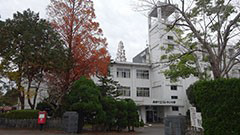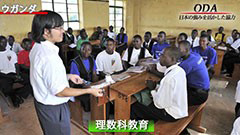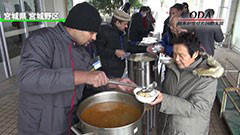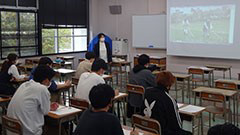Utilize for the class of "Social development and education" in Nagasaki Wesleyan University
On November 19, 2020, I utilized JICA-Net multimedia-based learning materials "Teaching materials for school about 'Refugees', 'Islam', 'Official Development Assistant' and 'School Education'" for the 8th class of "Social development and education", which is a professional education subject in Department of Economic Policy, Faculty of Contemporary Social Studies, Nagasaki Wesleyan University.

Nagasaki Wesleyan University
In the "Social development and education", through the lecture and group work, I set a goal for students to learn social development, international cooperation, the necessity and the way of aid, and the role of education in social development, and make students think deeply what they can do as a citizen.
The 8th class's subject was "To know the current situation of international cooperation and think its necessity and problems". When I took up ODA as an example about the current situation of Japanese international cooperation, I screened the material to 24 students who are studying in Department of Social Welfare and Department of Economic Policy.
The material shows 4 themes shortly.

Japan Overseas Cooperation Volunteers (JOCV) have been engaged in the field of science and mathematics education, in Uganda.
The material "Teaching materials for school about 'Refugees', 'Islam', 'Official Development Assistant' and 'School Education'" includes many videos such as JICA project, news report from NHK or world media, and exclusive interviews, which are edited to around 10 minutes length for using in a class and divided into 4 themes: "Refugees", "Islam", "Official Development Assistant" and "School Education".
Until last year, I had lectured about the current situation of international cooperation with general data sources. Our students were able to understood Japanese aid for many countries vaguely, however, it seemed difficult to feel the reality of the necessity and problems about aid and their understandings was on a superficial level. While I had been searching the idea and the material for the class that students would be more interest in and learn in a visual way on the internet, I met this material. Because this material enables users to image concretely by videos, which are made shortly, I thought learning content was deepened with inserting group work among each video.
As a clue to think international cooperation
In the class, by using development education materials, students have been learning through group work what the aid was and how the aid should be. Based on that learning, in this classwork, they thought what international cooperation and ODA were, the feature, role and significance of the aid by Japan were, through watching following 3 videos from this material.
Each videos are short-time long videos within 2 or 3 minutes. "What are international cooperation and ODA?" shows there are many problems in the world today and cooperation among countries is required to solve them. "The example of Japanese international cooperation and ODA" introduces the example of Japanese aid in Afghanistan. "International cooperation to solve problems together" introduces the examples of a variety of Japanese distinctive aid, the examples of the aid from other countries and international organizations to Japan in the period of post-war reconstruction and after Great East Japan earthquake. These shows that international cooperation has never been one-sided.

After Great East Japan earthquake, hot meals were served to disaster victims from around the world. 163 countries and 43 organizations aided for Japan.
To become familiar with International cooperation by videos

Students were watching the material in the class.
Students gave me impressions for the class, "I understood the necessity of aid and cooperation with each other.", "I have never known that Japan had been received aid from other countries" and so on. In Japan, people incline to regard problems of poverty and conflict as matters that exist in faraway place that has nothing to do with our own country. However, Japan has relation with those problems and we are all never unrelated, and for improvement of problems that has been occurring today in developing and developed countries, it is important for us to effort with cooperating and collaborating among various organizations and people.
I felt students got the above awareness through the class. Especially by videos, I think students could feel more closely how the people who aided by Japan live their life, what the problems they have, the significance of Japanese aid, and the fact that Japan also has been aided by other countries. On this time, while I read students' impressions, pause to realize visual materials' usefulness. I expect that JICA-Net multimedia-based learning materials will become a clue for many students to think various problems that occur in the world.
Yoshiko Sugawara
Professor
Department of Economic Policy
Faculty of Contemporary Social Studies
Nagasaki Wesleyan University
*The Material(s) mainly applied
Teaching materials for school about "Refugees", "Islam", "Official Development Assistant" and "School Education"
The material includes many videos such as JICA project, news report from NHK or world media, and exclusive interviews, which are edited to around 10 minutes length for using in a class and divided into 4 themes: "Refugees", "Islam", "Official Development Assistant" and "School Education".
- YouTube (external link)




scroll